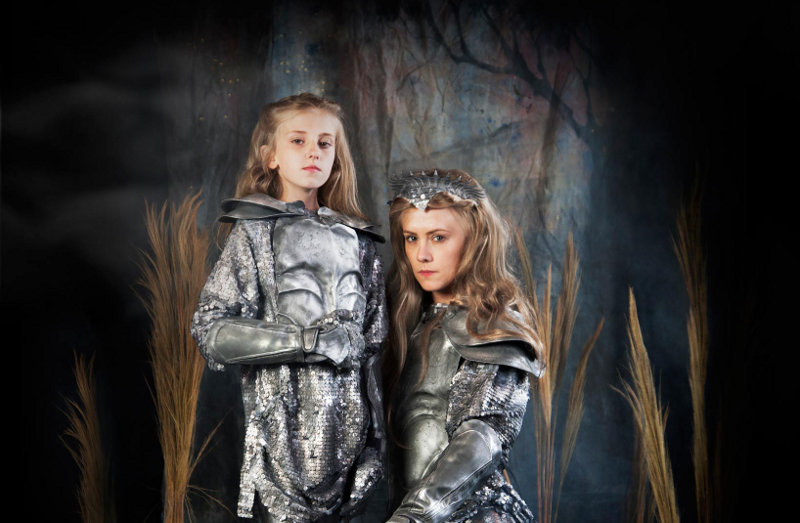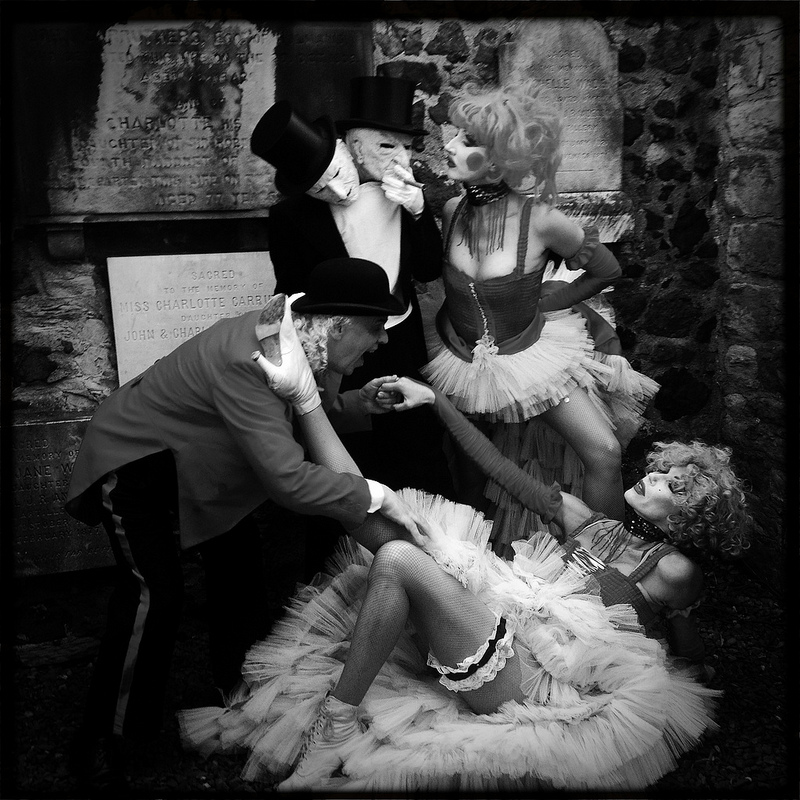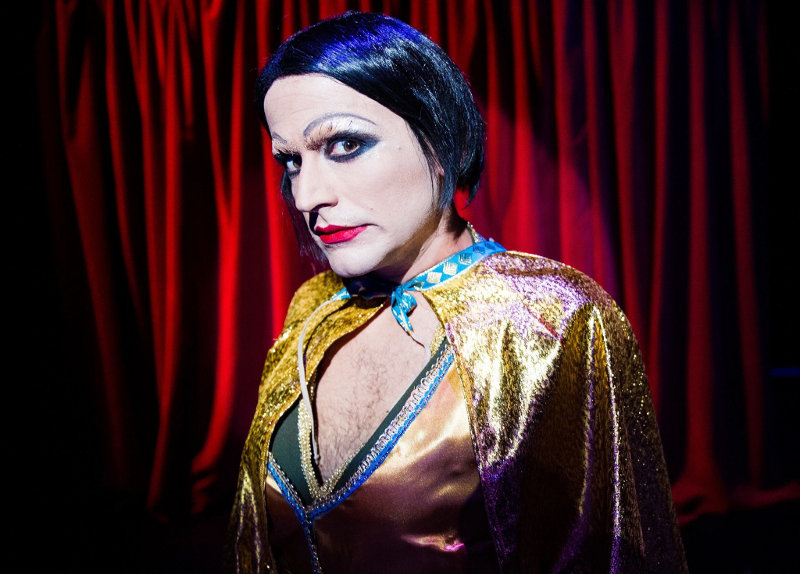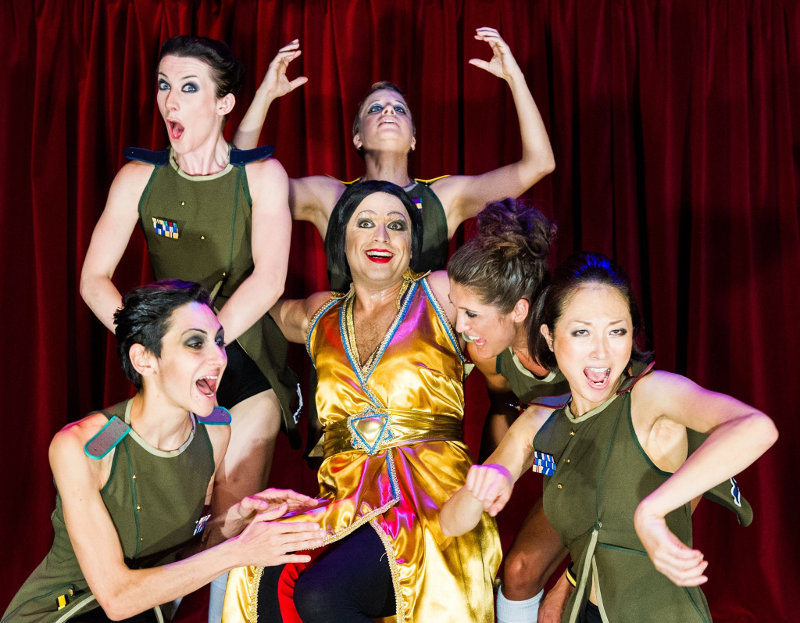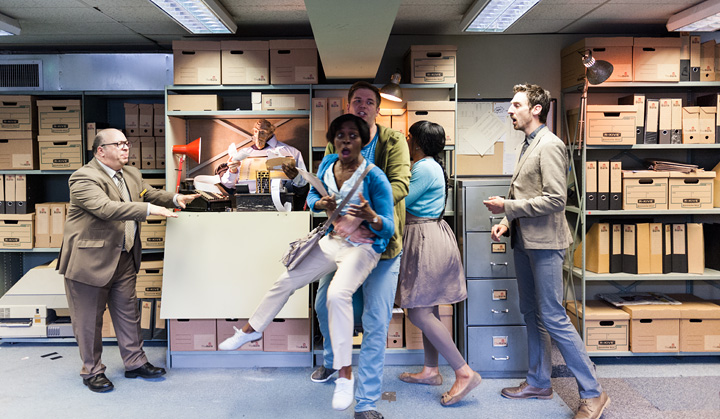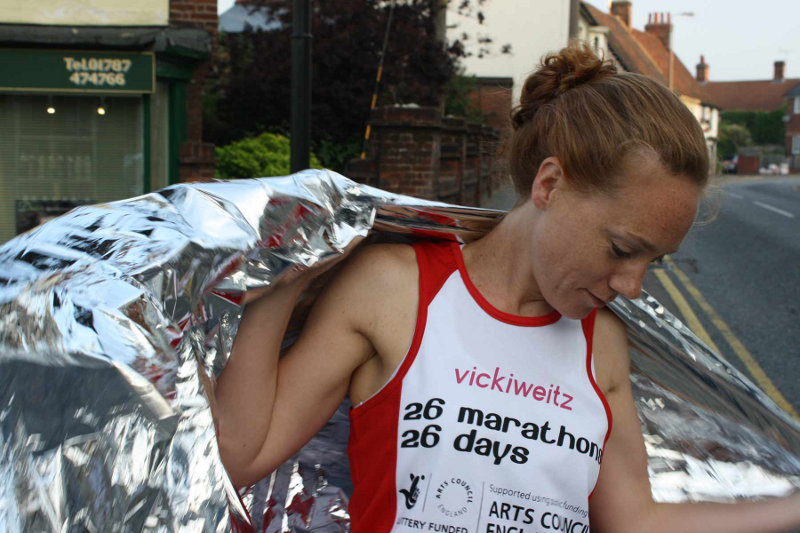
The arrival of the Edinburgh Fringe brochure at the Total Theatre editorial office always arouses mixed feelings – a frisson of excitement, of course, at the thought of a month-long bonanza of theatre, but also a sense of dread at the prospect of wading through something the size of a telephone directory, trying to work out what shows should be on Total Theatre’s radar.
Sometimes it’s obvious – a listing in the Dance & Physical Theatre category helps – but often it isn’t. And some companies are notoriously bad at selling themselves: it can be hard to tell what’s being presented in some cases. There’s also the additional element that some shows nowadays aren’t listed in the official programme – there is, for example, a whole raft of work presented as part of the Forest Fringe, which this year is based at the Drill Hall in Leith, that isn’t a part of the ‘official’ Fringe. More on that later…
There are so many shows to potentially mention that we are restricting ourselves here to previous Total Theatre Award winners or shortlisted companies; work by companies that we are familiar with; and work previously favourably reviewed by Total Theatre – plus also flagging up a few key venues and organisations, and noting a few wild card ‘unknowns’ that tickle our fancy. For full details of all these name-checked shows, see the Fringe website.
So we’ve done some of the work for you – here’s a round-up of Total Theatre recommendations and suggestions, for your edification and enjoyment.
First to say is that there’s a whole raft of circus work in Edinburgh this year. Previous Total Theatre Award winners NoFit State bring two shows to the Fringe, the large-scale delight Bianco (set in the company’s own spaceship tent at Fountainbridge) and a funtime lunchtime offering called Noodles, on the menu at New Town Theatre. Circus producers Crying Out Loud are offering a trio of circus or visual theatre pieces at Edinburgh’s hottest venue, Summerhall, including La Poème by bearded lady Jeanne Mordoj of Compagnie Bal. Crying Out Loud are also presenting Pirates of the Carabina’s family-friendly circus show Flown at the Underbelly in Bristo Square. Also at the Underbelly are Australian favourites Circa with Wunderkammer, and at Assembly Mound the marvellous (and oft reviewed by TT) Gandini Juggling with Smashed. Australian circus favourites Casus return with their Awards shortlisted hit Knee Deep, and Aurora Nova / Circle of Eleven are back with Leo.
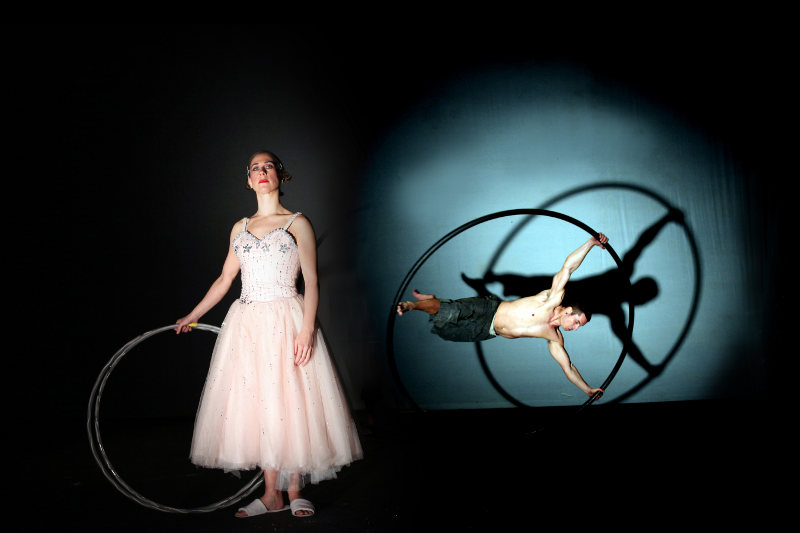
Pirates of the Carabina, Flown
Circus-related, we should also mention former Cirque du Soleil clown, Julien Cottereau, returning to the Fringe with his signature mime show Imagine Toi, an old favourite seen and loved by Total Theatre on numerous previous occasions. A couple of wild-card circus possibilities are Edinburgh-based Voice Box with Grendel, a circus-storytelling interpretation of Beowulf; and Adelaide Fringe hit Fright or Flight, presented at the Assembly Roxy.
Theatre Re’s The Little Soldiers looks interesting – less actual circus, more circus as a metaphor – a story set in a circus tent of sibling rivalry to the death. Rhum and Clay have found favour with TT at previous Fringes and they return this year with an ‘absurdist clown’ show, Man in the Moone. Also absurdist, probably darker and more disturbing (but who knows?), Total Theatre Award nominees 2012 (best emerging company) Clout are back at Summerhall with their latest show, The Various Lives of Infinite Nullity, which ‘cannibalises’ the literature of renegade Irish writer Flann O’Brien. Another former Awards nominee at Summerhall is the ever-enterprising Dudendance, with a site-specific piece called This Side of Paradise, exploring obsessive visions of the apocalypse.
Summerhall deserves its own special mention: in the past three years it has established itself as the most enterprising new venue in Edinburgh, home to much of the physical, visual and experimental theatre and performance that Total Theatre has always supported. Its eclectic programme includes a very wide variety of forms, set in many different spaces. There’s Daydream, a buzzing bees installation in the courtyard; Dark Matter, a journey through the night garden with Scottish animators Vision Mechanics; and Major Tom, featuring the wonderful Victoria Melody and her trusty hound Tom. Late openers at Summerhall include David Rosenberg’s Ring; Common Wealth’s Our Glass House, a site-specific performance about domestic abuse (staged in a residential house); The Paper Cinema’s live animation delight Odyssey; and Vincent Dance Theatre’s Motherland (all previously reviewed by Total Theatre). There’s also Made in China’s Gym Party; Michael Pinchbeck’s The Beginning, the end of his trilogy which started with The End; and Sue MacLaine’s Sid and Valerie, in which the actor/writer (previously nominated for a Total Theatre Award for Still Life) shows another side to herself as her male alter-ego, the one-time vaudeville star Sid Lester (aided and abetted by Emma Kilbey as Sid’s wayward daughter Valerie). We’ve noted that some Summerhall shows haven’t made it into the main Ed Fringe brochure – for example, Beating McEnroe by Chris Goode collaborator Jamie Wood – so it’s worth taking a look at their own programme here. If you have just a day or two in Edinburgh, you could do worse than booking yourself into a batch of Summerhall shows…
Another Summerhall highlight is Somnambules and the 7 Deadly Sins – an ‘epic journey through time and art’ – by Yael Karavan and Tanya Khabarova, both formerly of Derevo (who have won more Total Theatre Awards than any other company). This show was reviewed and loved by Total Theatre in an earlier incarnation, and we are very excited to be seeing the results of a year’s intensive redevelopment. Note: this show rather oddly got listed under Music rather than Dance & Physical Theatre, one of a number of interesting anomalies in the Fringe brochure!)
More Russian superstars: BlackSkyWhite won a Total Theatre Award for Bertrand’s Toys many years ago, and have subsequently been nominated for Astronomy for Insects, both of which were shown to great acclaim at the London International Mime Festival. They return triumphant to the Fringe with another dark and broody piece of highly physical theatre, Omega, a ‘hoochie coochie carnival for the end of time’, presented at The Assembly Rooms on George Street.
There’s a number of enterprising dance artists at Edinburgh this year: Dan Canham (formerly of DV8 / Punchdrunk / Kneehigh) presents Ours Was the Fen Country, which combines music, movement and words ‘to evoke the mysterious landscape of the Fens’ at Dance Base; h2dance return with a dance-comedy piece, Duet, at Zoo Venues; and Lost Dog / Trestle collaborate on It Needs Horses / Home for Broken Turns at Zoo Southside. All these shows are late-openers as part of the British Council Showcase, which runs 19–26 August at various venues.
As is Idle Motion’s Borges and I, another show previously shortlisted for an Award (Best Newcomer). Their new show, That Is All You Need to Know (listed under Spoken Word rather than Theatre, for some reason) has a full run at Zoo Southside. Also crossing the divide between theatre and spoken word comes Kate Tempest with Brand New Ancients (another late opener). We note also that some companies are premiering new shows whilst also presenting previous successes: Total Theatre Award winners Look Left Look Right are at Fringe 2013 with The Love Project, but from the 12th onwards there’s also another chance to see You Once Said Yes.
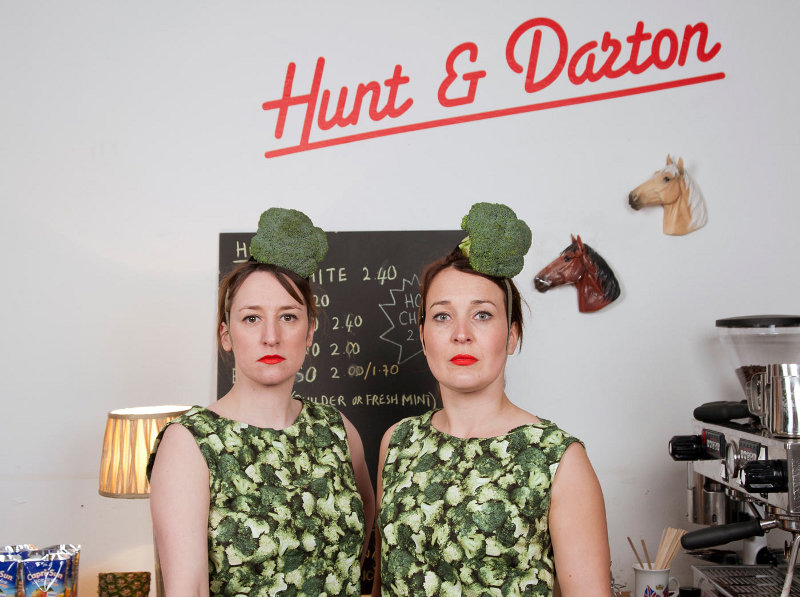
Hunt & Darton Cafe
Sitting somewhere between movement-based theatre and performance art: Mamoru Iriguchi’s Projector/Conjector is a multimedia live art piece inspired by Swan Lake and Star Wars, a winning combination; and Rosie Kay and Guilherme Miotto team up with film-maker Louis Price for Sluts of Possession (best title at this year’s Fringe?). If live art is your thing, then make sure you catch Sylvia Rimat’s I Guess if the Stage Exploded… Also live art-ish are the various goings on at the Hunt & Darton Cafe, located once again on St Mary’s Street. During the day there are various installations, living artworks and interventions happening. In the evening there are ‘proper’ shows (if we are allowed to make the distinction), including Jenny Hunt and Holly Darton’s own Boredom, and the always-entertaining Richard DeDomenici with Popaganda. The Hunt & Darton Cafe (part of the enterprising Escalator East to Edinburgh programme) is this year under the auspices of the Pleasance.
Other Escalator shows at Pleasance include two previous Total Theatre Award winners with new shows: Gecko with Missing, a ‘warped journey into the depths of the human psyche’; and the ‘audacious, provocative’ Bryony Kimmings and her 9 year-old niece Taylor taking on the global tween machine in Credible Likeable Superstar Role Model. Previously shortlisted company Badac Theatre are back with another hard-hitting piece of visceral political theatre, ANNA, which investigates the death of Russian journalist Anna Politkovskaya. Other Escalator East shows we’ll be looking out for are storyteller extraordinaire Chris Dobrowolski’s All Roads Lead to Rome, the lovable Little Bulb Theatre’s Squally Showers, Flabbergast Theatre’s Boris and Sergey II (dark and twisted puppet theatre for grown-ups), Liz Crowe’s 30 hour durational piece Bedding Out (eat your heart out John and Yoko), and – also durational, this time over 26 days (eat your heart out Bootworks) – vickiweitz’s 26 Marathons in 26 Days, that is 26.2 miles as a marathon should be, daily run up and down the Royal Mile. God help her. If you can’t face the thought of trying to find her there amongst the ardent leafleteers and high-school dramatists, then you can follow her blog.
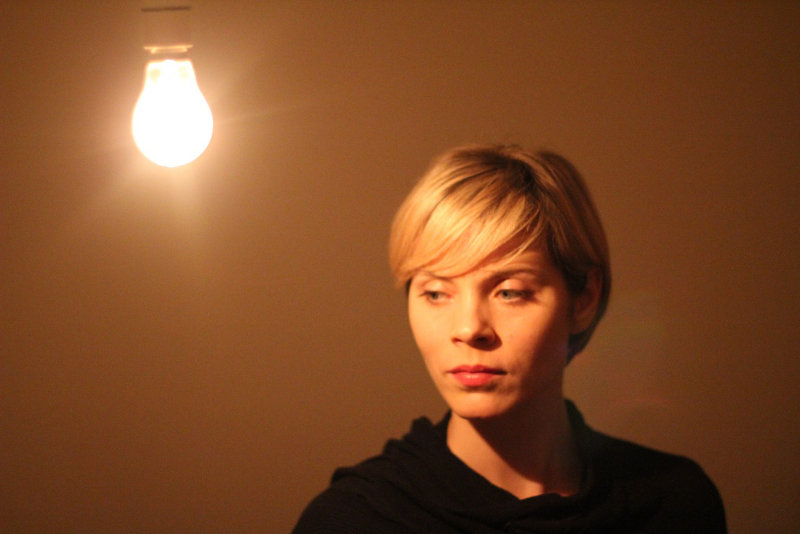
Badac Theatre, Anna
Meanwhile, over at Northern Stage at St Stephen’s, the admirable Third Angel have requisitioned a minibus for Cape Wrath, the story of Britain’s longest bus journey; and Daniel Bye (who was shortlisted at last year’s Total Theatre Awards for The Price of Everything) returns with new show How to Occupy an Oil Rig, a ‘playful and provocative contemplation on protest’. There’s also the opportunity to see The Price of Everything, which is back for a short run – as is Third Angel’s What I Heard About the World. Also at Northern Stage, The Paper Birds combine physical theatre and new writing, no doubt with their customary skill, in On the One Hand, which gives us six women of different ages exploring the ageing process. The space between new writing and physical/devised theatre is also the territory of Move to Stand, whose Collision of Things comes to Pleasance Courtyard.
The Traverse, Edinburgh’s year-round home of new writing, has in recent years pushed its boundaries in the direction of ‘total theatre’. This year’s programme includes a number of companies of interest, including David Leddy with Long Live The Little Knife, ‘an uplifting caper about forgery, castration, and drunkenness’; and one of the first ever Total Theatre Award winners, Theatre O, with a vaudevillian reworking of Joseph Conrad’s The Secret Agent, offering a ‘heartbreaking but hilarious’ look at secret terror cells, political conspiracy, and police bungling. Multi-award winners Ontroerend Goed are this year presenting Fight Night, an interactive piece billed as ‘elections as theatrical gaming’; and their producer David Bauwens is also moonlighting at Summerhall and elsewhere with an enterprising bill of new Belgian work called – yes, you’ve guessed – Big in Belgium. Another interesting curated mini-programme at this year’s Fringe is the BE (Birmingham European) Festival programme – a selection of past winners presented outside of the festival’s own context. This includes the winner of the BE Mise en Scene prize 2012, Fantasy No. 10 – The Beauty of Life by the Granada-based Vladimir Tzekov Stage Action Laboratory.
Over at the Pleasance, the brave and true Belarus Free Theatre will be tackling the darkest manifestations of human behaviour at their Capital Punishment Café, which will be offering electrocution, hanging and death by lethal injection. Not for real, we hope. Also taking a satirical, perhaps even Brechtian, look at politics using song-and-dance and drag is the always interesting Theatre Ad Infinitum, who present Ballad of the Burning Star, company co-director Nir Paldi’s investigation of his own identity as a gay Israeli man. This looks to be a very different kettle of fish to their previous Edinburgh Fringe (and indeed worldwide) success, Translunar Paradise – although this resourceful company have embraced many different theatrical styles over the years, so we shouldn’t be surprised if one show is very different to its predecessor; that’s been their story all along. The new show is playing at the Pleasance Dome, where you will also find Lucy Hopkins with her one-woman physical theatre/clown show Le Foulard (The Veil), which Total Theatre knows very little about – but we’re interested in finding out more! Another one-woman show, Claudia Jefferies’ Jewel, is inspired by the beauty pageant culture in the USA, and described as ‘grotesque and funny’. We hope so. Also hopefully funny (it’s listed under Cabaret) is Evi Stamatiou’s solo physical comedy show Caryatid Unplugged, which combines traditional Greek music and clowning, and which is part of a programme of solo shows presented at the Hill Street Theatre, a very lovely little venue north of Princes Street. Other Cabaret treats include Briefs: The Second Coming (which might be camp as Christmas but features some top-notch circus skills); the return of La Clique at The Famous Spiegeltent; and Miss Behave’s Game Show. If warped cabaret is your wont, then look out for EastEnd Cabaret’s Dirty Talk; Frank Sanazi’s Das Vegas Night II; and The Worst of Scottee, over at the other Assembly in George Square. And no, I don’t know if all the various ‘Assemblies’ have mended their differences or whether it is still turf wars.
Fans of puppetry and object animation are advised not to miss the legendary Philippe Genty company with Dustpan Odyssey; Stan’s Café The Cardinals; and Tortoise in a Nutshell’s Feral. Other puppetry delights include the previous Award winners Bunk Puppets with Slapdash Galaxy: 3D; and The Wrong Crowd (shortlisted as best newcomer for The Girl with the Iron Claws) who return to the Underbelly with HAG. Total Theatre also has its eye on Brazilian puppetry/visual theatre show The Weaver, which is at New Town Theatre. Jammy Voo’s Birdhouse features puppetry, clowning, live music and a whole lot more – and comes from a company we’ve been watching for a while.
Other goodies: over at the Assembly Roxy, street theatre company Wet Picnic premiere their first indoor theatre show, Death and Gardening. Another Assembly one we’ll be wishing every success for is TOOT’s Ten Out of Ten, co-created by dANTE OR dIE’s Terry O’Donovan, who’ll be hot-footing it up to Edinburgh after showing his company’s site-specific success I Do at the Almeida 31 July – 2 August. Cutting it a bit fine aren’t we, Terry? (This one is at Assembly Mound.)
There’s a number of interesting music-theatre pieces: Awards shortlisted show Beulah returns to Fringe 2013; previous winner Cora Bissett and The Arches present Whatever Gets You Through the Night at The Queen’s Hall; Théâtre Sans Frontières bring a satirical musical about financial crises called Canary Gold to C Chambers; and Pippa Bailey’s international music-theatre experiment BiDiNG TiME returns to Summerhall in a new incarnation.
And so – that’s our trawl through the Fringe brochure for you. It just remains to flag up the Forest Fringe programme, which is not part of the ‘mainstream Fringe’ and which can be viewed here.
Highlights include Tim Crouch, fresh from the Almeida; perennial favourites Action Hero; Forest co-directors Andy Field and Deborah Pearson with their own solo ventures; and a trilogy of works from Brian Lobel. Most shows are on for just a few days, and entrance (if you can fight your way in) is by donation.
The Total Theatre team will be frantically racing around Edinburgh reviewing and blogging over the next three weeks, so if you can’t make it to the Fringe you can keep up with it all here on the website. Finally, if you want to find out more about the Total Theatre Awards see the dedicated section of this website where you will find information on the application and judging processes. We will be posting lists of Awards nominees after 15 August, and winners after 22 August.
And so, once more into the breach dear friends… the Fringe is nigh!

